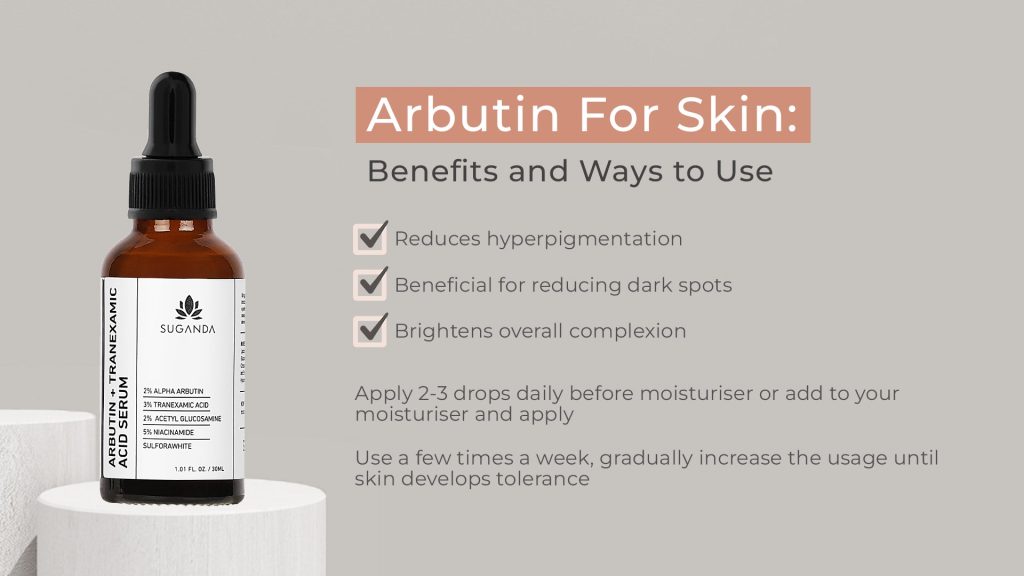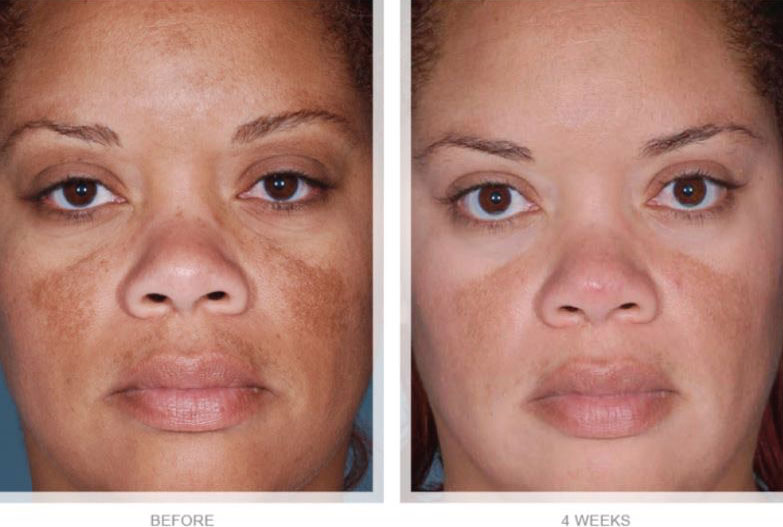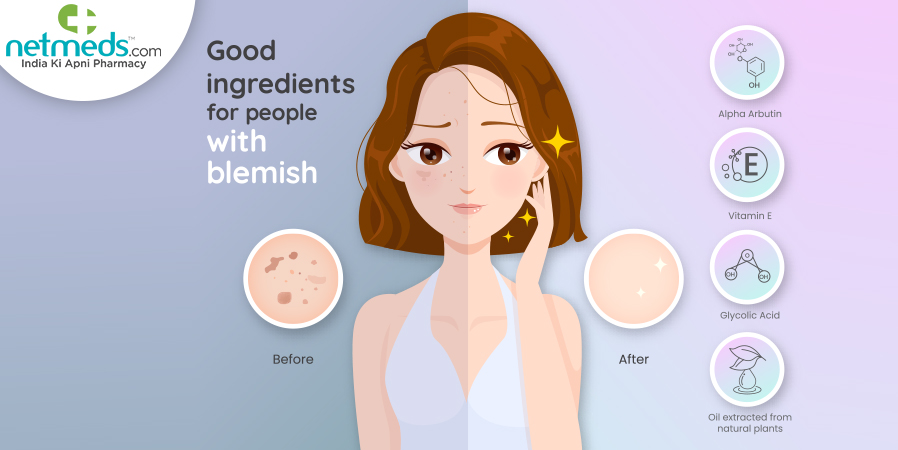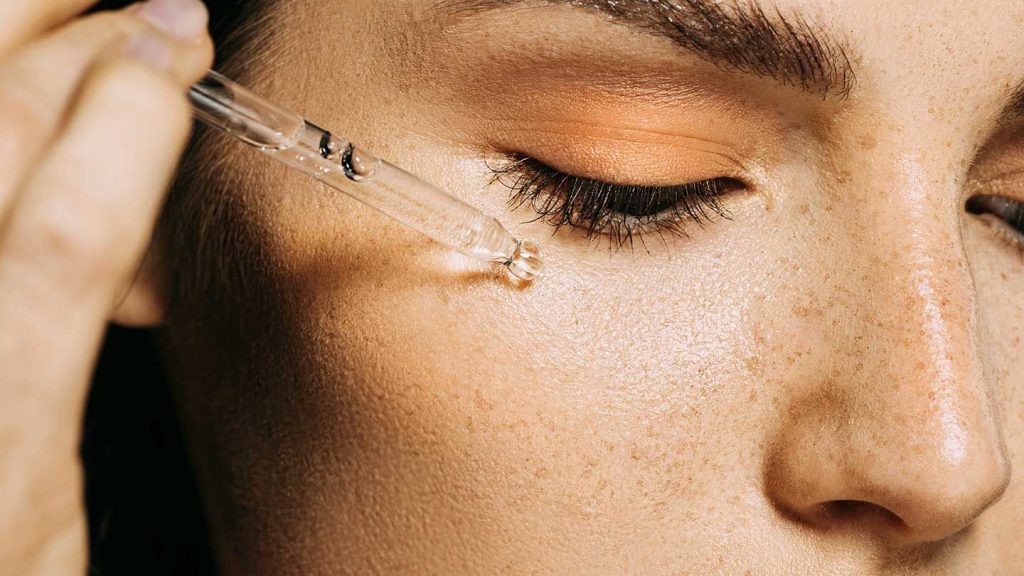Imagine finally finding a solution to your hyperpigmentation woes – a natural ingredient that can effectively lighten dark spots and even out your skin tone. Arbutin, a plant-derived compound found in a variety of skincare products, has emerged as a formidable ally in the battle against hyperpigmentation. But what exactly is its role in treating this common skin condition? Let’s delve into the fascinating world of arbutin and discover how it works its magic on hyperpigmented skin.
Understanding Hyperpigmentation
Definition of Hyperpigmentation
Hyperpigmentation refers to the darkening of certain areas of the skin due to an overproduction or accumulation of melanin, the pigment responsible for the color of our skin, hair, and eyes. This condition can result in patches or spots that are darker than the surrounding skin, leading to an uneven complexion.
Causes of Hyperpigmentation
There are various factors that can contribute to the development of hyperpigmentation. One common cause is excessive sun exposure, which stimulates the production of melanin as a natural defense mechanism. Hormonal changes, such as those experienced during pregnancy or as a result of certain medications, can also trigger the appearance of dark spots. Other causes include skin trauma or inflammation, certain medical conditions, and genetic predisposition.
Types of Hyperpigmentation
There are different types of hyperpigmentation, each characterized by its underlying cause and appearance. The most common types include:
-
Sunspots or age spots: These are small, flat, light-to-dark brown spots that typically appear on areas frequently exposed to the sun, such as the face, hands, and shoulders.
-
Melasma: Melasma presents as larger patches of darkened skin, often on the face. It is more common in women and can be triggered by hormonal fluctuations, pregnancy, birth control pills, or certain medications.
-
Post-inflammatory hyperpigmentation: This type of hyperpigmentation occurs after an injury, inflammation, or skin condition like acne. It causes dark spots to appear in the affected areas.
-
Freckles: Freckles are small, light brown spots that are typically genetic and appear on fair-skinned individuals, especially after sun exposure.
What is Arbutin?
Definition of Arbutin
Arbutin is a naturally occurring compound that is commonly derived from the leaves of certain plants, such as bearberry, cranberry, and blueberry. It belongs to a class of compounds known as glycosides and is widely recognized for its skin lightening and brightening properties. Arbutin acts by inhibiting the activity of an enzyme called tyrosinase, thereby reducing the production of melanin.
Sources of Arbutin
Arbutin can be found in several plant species, with bearberry being one of the most well-known sources. It has been used for centuries in traditional medicine and skincare in various cultures around the world. Nowadays, arbutin is also commonly synthesized in laboratories for use in cosmetic and skincare products.
Properties and Mechanism of Action
Arbutin possesses several properties that make it an effective ingredient for treating hyperpigmentation. Firstly, it is a potent antioxidant, helping to protect the skin against damage caused by free radicals. Secondly, arbutin has been found to inhibit the activity of tyrosinase, an enzyme involved in the production of melanin. This inhibition helps to reduce the formation of melanin, resulting in a lighter and more even skin tone.
Arbutin is considered a safe and gentle ingredient, making it suitable for various skin types. Its mechanism of action involves suppressing the production of melanin, rather than bleaching or stripping away the existing pigment. This makes it particularly appealing for individuals with sensitive or easily irritated skin.

Arbutin’s Role in Treating Hyperpigmentation
Inhibition of Melanin Production
One of the primary ways in which arbutin addresses hyperpigmentation is by inhibiting the production of melanin. Melanin is produced by specialized cells called melanocytes, which are activated by the enzyme tyrosinase. Arbutin works by interfering with the activity of tyrosinase, thereby reducing the amount of melanin produced. This leads to a gradual lightening of dark spots and an overall more even complexion.
Prevention of Melanosome Formation
Melanosomes are small structures within melanocytes that transport melanin to nearby skin cells. Arbutin has been shown to inhibit the formation of melanosomes, preventing the transfer of melanin to the surrounding skin cells. By interfering with the transport process, arbutin helps to minimize the appearance of dark spots and promote a more balanced skin tone.
Reduction in Existing Hyperpigmentation
In addition to preventing the formation of new dark spots, arbutin has also been found to reduce the intensity of existing hyperpigmentation. Its inhibitory effects on tyrosinase activity can help fade dark spots over time, leading to a more uniform complexion. Consistent use of arbutin-containing products can result in a gradual lightening of pigmented areas, giving the skin a brighter and more radiant appearance.
Balancing Uneven Skin Tone
Arbutin not only targets specific areas of hyperpigmentation but also works to balance the overall skin tone. By inhibiting the production of melanin and promoting a more even distribution, arbutin helps to achieve a uniform complexion. This can be especially beneficial for individuals with patches of uneven pigmentation, as arbutin can help blur the boundaries between dark and light areas, resulting in a harmonious and balanced appearance.
Scientific Studies on Arbutin
Study 1: Efficacy of Arbutin Cream in Hyperpigmentation
A study published in the Journal of Dermatological Treatment evaluated the efficacy of an arbutin cream in treating hyperpigmentation. The researchers found that the arbutin cream significantly reduced the severity and size of hyperpigmented areas after 12 weeks of use. They concluded that arbutin is an effective and well-tolerated ingredient for improving the appearance of hyperpigmentation.
Study 2: Comparison of Arbutin with Other Skin Lightening Agents
Another study conducted by researchers in South Korea compared the effectiveness of arbutin with other commonly used skin lightening agents. The study found that arbutin demonstrated comparable efficacy in reducing hyperpigmentation, while also being more gentle and less likely to cause skin irritation compared to some other ingredients. This suggests that arbutin can be a suitable alternative for individuals seeking a gentler treatment option for hyperpigmentation.
Study 3: Long-term Effects of Arbutin in Hyperpigmented Skin
A long-term study published in the Journal of Cosmetic Dermatology investigated the effects of arbutin on hyperpigmentation over a period of six months. The researchers found that regular use of an arbutin-containing cream resulted in a gradual lightening of hyperpigmented areas, with significant improvement observed after three months of treatment. The study concluded that arbutin can be an effective long-term solution for individuals looking to address hyperpigmentation concerns.

How to Use Arbutin for Hyperpigmentation
Choosing the Right Arbutin Product
When selecting an arbutin product for treating hyperpigmentation, it is important to consider factors such as the concentration of arbutin, the formulation, and the reputation of the brand. Higher concentrations of arbutin may provide faster and more noticeable results, but it is also essential to ensure the product is well-formulated and suitable for your skin type. Look for products that have undergone rigorous testing, are free from harsh irritants, and have positive customer reviews.
Application and Dosage
Arbutin is commonly found in various skincare products, including creams, serums, and masks. Follow the instructions provided by the manufacturer for the specific product you choose. Generally, apply a thin and even layer of the arbutin product to cleansed skin, focusing on the areas of hyperpigmentation. Gently massage or pat the product into the skin until fully absorbed. It is typically recommended to use arbutin-based products once or twice daily, depending on the concentration and formulation.
Combining Arbutin with Other Skincare Ingredients
Arbutin can be combined with a range of other skincare ingredients to enhance its effects or target additional concerns. One popular combination is arbutin with vitamin C, as both ingredients possess brightening properties and can work synergistically to promote a more even complexion. Niacinamide, known for its skin brightening and soothing effects, can also be paired with arbutin. Additionally, some individuals may choose to use alpha arbutin, a more potent variant of arbutin, for enhanced results. Hyaluronic acid can be used alongside arbutin to provide hydration and plumpness to the skin while addressing pigmentation concerns.
Precautions and Potential Side Effects
While arbutin is generally considered safe for most individuals, it is essential to be mindful of potential side effects. Some people may experience mild skin irritation, redness, or itching when first using arbutin-containing products. If any adverse reactions occur, discontinue use and consult a dermatologist. It is also crucial to use sunscreen daily when using arbutin, as the skin may become more sensitive to the sun’s rays. Always patch test new products before applying them to larger areas of the skin and follow the instructions provided by the manufacturer.
Benefits of Arbutin over Other Hyperpigmentation Treatments
Natural and Plant-Derived Ingredient
One of the key advantages of arbutin is its natural origin. Derived from plants, arbutin offers a more natural alternative to synthetic ingredients often found in other hyperpigmentation treatments. This can be particularly appealing to individuals who prefer using products with ingredients derived from nature.
Gentle and Safe for Most Skin Types
Arbutin is generally well-tolerated by most skin types, including sensitive or easily irritated skin. Unlike some other ingredients used in hyperpigmentation treatments, arbutin tends to have a gentler and more soothing effect on the skin. This makes it a suitable option for individuals with skin sensitivities or those seeking a milder approach to addressing hyperpigmentation.
Non-Hydroquinone Alternative
Hydroquinone is a commonly used ingredient in many hyperpigmentation treatments due to its potent skin-lightening properties. However, it is also known for its potential side effects, such as skin irritation and increased sensitivity to the sun. Arbutin provides a non-hydroquinone alternative, offering similar efficacy in reducing hyperpigmentation without the associated risks or drawbacks.
Suitable for Long-term Use
Another advantage of arbutin is its suitability for long-term use. Due to its gentle nature and the absence of harsh ingredients, arbutin-based products can be used consistently over an extended period without causing excessive dryness, irritation, or other adverse effects. This makes arbutin a viable option for individuals looking to incorporate a stable and long-term solution into their skincare routine.

Arbutin vs. Hydroquinone
Comparison of Mechanism of Action
Arbutin and hydroquinone both exert their effects on hyperpigmentation by inhibiting the production of melanin. However, they differ in their methods of action. Arbutin reduces melanin production by inhibiting the activity of tyrosinase, while hydroquinone functions by disrupting the synthesis of melanin precursors. Despite these differences, both arbutin and hydroquinone have been shown to effectively lighten hyperpigmentation.
Side Effects and Safety Profile
Hydroquinone has long been associated with potential side effects and safety concerns. These include skin irritation, redness, dryness, and increased sensitivity to the sun. On the other hand, arbutin has a favorable safety profile and is generally well-tolerated, with a lower risk of side effects. Individuals with a history of skin sensitivity or those with concerns about potentially harsher treatments may find arbutin to be a suitable alternative.
Effectiveness in Treating Hyperpigmentation
Numerous studies have demonstrated the efficacy of both arbutin and hydroquinone in treating hyperpigmentation. While hydroquinone may provide faster and more pronounced results, arbutin has shown comparable efficacy in reducing the appearance of dark spots and achieving a more even skin tone. The choice between arbutin and hydroquinone depends on individual preferences, skin sensitivity, and the severity of hyperpigmentation.
Combining Arbutin with Other Skincare Ingredients
Vitamin C
Vitamin C is a powerful antioxidant known for its skin brightening and collagen-boosting properties. When combined with arbutin, it can enhance the overall efficacy of the treatment, as both ingredients work to promote a more even complexion. Vitamin C can also provide additional protection against environmental damage and improve the skin’s overall health.
Niacinamide
Niacinamide, also known as vitamin B3, is a versatile ingredient that offers multiple benefits for the skin, including improving the appearance of hyperpigmentation. When used alongside arbutin, it can help to further reduce the severity of dark spots, calm inflammation, and restore the skin’s natural barrier function.
Alpha Arbutin
Alpha arbutin is a more potent form of arbutin, known for its ability to deliver faster and more noticeable results. By combining alpha arbutin with regular arbutin, individuals with stubborn or severe hyperpigmentation can potentially achieve improved outcomes in terms of lightening dark spots and achieving a more uniform complexion.
Hyaluronic Acid
Hyaluronic acid is a hydrating ingredient that can help to improve the skin’s moisture levels and plumpness. When used with arbutin, it can provide additional hydration, which is essential for maintaining healthy and radiant-looking skin. Hyaluronic acid can also enhance the overall absorption and penetration of arbutin into the skin, maximizing its effectiveness.

Arbutin Products in the Market
Topical Creams and Serums
Arbutin is commonly found in various topical creams and serums specifically formulated to target hyperpigmentation. These products often contain other beneficial ingredients, such as antioxidants and moisturizers, to enhance the overall efficacy and provide additional skincare benefits. When choosing a cream or serum, consider factors such as the concentration of arbutin, formulation, and reputation of the brand.
Sheet Masks
Sheet masks infused with arbutin can provide a convenient and intensive treatment for hyperpigmentation. These masks are typically soaked in a serum or essence containing arbutin, allowing for direct and concentrated application to the skin. The mask sheet helps to lock in moisture and increase the absorption of arbutin, maximizing its effects on hyperpigmentation.
Cleansers and Toners
Arbutin can also be found in cleansers and toners, which are formulated to prepare the skin for subsequent skincare steps and improve overall skin tone. Cleansers with arbutin can help to gently cleanse the skin while minimizing the appearance of dark spots. Toners containing arbutin offer a lightweight and refreshing way to incorporate the ingredient into a skincare routine, while providing additional hydration and balance.
Sunscreen with Arbutin
To prevent further darkening of hyperpigmented areas, it is essential to protect the skin from harmful UV rays. Sunscreens containing arbutin offer the dual benefit of sun protection and skin lightening. These sunscreens are formulated to provide broad-spectrum protection while addressing existing hyperpigmentation, making them a comprehensive solution for maintaining a more even and protected complexion.
Conclusion
Arbutin plays a significant role in treating hyperpigmentation by inhibiting melanin production, reducing the appearance of existing dark spots, and balancing uneven skin tone. Scientific studies have demonstrated the efficacy and safety of arbutin as a skincare ingredient for addressing hyperpigmentation. When choosing arbutin products, it is important to consider factors such as concentration, formulation, and brand reputation. Arbutin offers several advantages over other hyperpigmentation treatments, including its natural origin, gentle nature, and suitability for long-term use. When compared to hydroquinone, arbutin provides a safer alternative with comparable effectiveness. Combining arbutin with other skincare ingredients such as vitamin C, niacinamide, alpha arbutin, and hyaluronic acid can further enhance its effects and address different skincare concerns. There are various arbutin-containing products available in the market, including topical creams and serums, sheet masks, cleansers and toners, and sunscreens. Understanding the role of arbutin and its potential benefits can empower individuals to make informed choices in their skincare journey. As research and development in the field of arbutin continue to progress, further advancements and refinements can be expected to optimize its use in treating hyperpigmentation.






